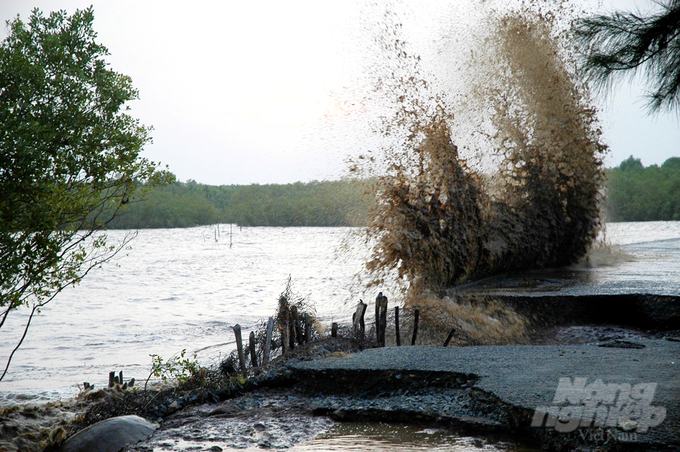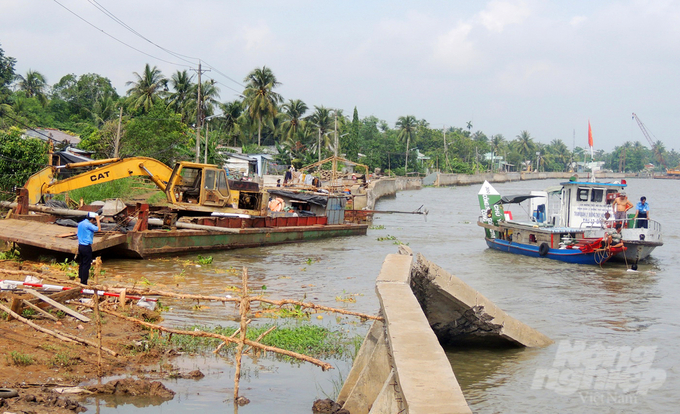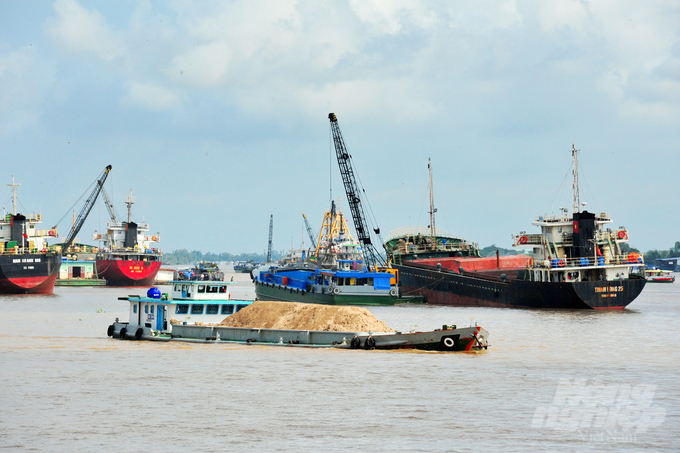June 21, 2025 | 01:37 GMT +7
June 21, 2025 | 01:37 GMT +7
Hotline: 0913.378.918
June 21, 2025 | 01:37 GMT +7
Hotline: 0913.378.918

The rainy season has recently started in the Mekong Delta, and multiple instances of riverbank erosion were reported, resulting in submerged civilian houses and damaged traffic infrastructure. Photo: Ho Thao.
Multiple provinces in the Mekong Delta, where the rainy season recently began, have reported several isntances of riverbank erosion, resulting in submerged civilian houses and damaged traffic infrastructure.
According to Dong Thap Province's Commanding Committee for Natural Disaster Prevention and Search and Rescue Acitivities, there have been 19 recorded instances of riverbank and canal erosion in Dong Thap since the beginning fo 2023. These natural disasters occured in the communes of Phuong Tra and Tan. Hoi Trung, An Binh, Tan Nghia, Nhi My, My Tho in Cao Lanh district; Tan Phu Dong, Tan Quy Tay in Sa Dec City; Hoa Tan, Phu Long, An Khanh in Chau Thanh district. Most notably, Can Lo canal in Nhi My commune, Cao Lanh district were affected by 7 of these instances.
The erosion occured on an area of approximately 2,000 square meters, with a total length of 553 meters. As a result, three houses collapsed, affecting fourteen families and causing over 1.3 billion VND in damages.
It is necessary to build embankments at critical locations due to the continuous riverbank erosion. However, experts believe that the arbitrary construction of embankments can lead to a shortage of fund.

Mr. Nguyen Huu Thien, an independent expert on the ecology of the Mekong Delta: "The riverbank had a structural damage that is unnoticeable from above the water surface". Photo: Le Hoang Vu.
According to the analysis of Mr. Nguyen Huu Thien, an independent expert on the ecology of the Mekong Delta, there are two main causes for erosion in the Mekong Delta; i.e: the lack of silt and sand in the riverbed due to the impact of hydroelectricity, and the impact of sand mining along the Mekong River.
The lack of silt forces the water to "eat" into the riverbank and the river bed. On the other hand, the lack of sand is the primary cause of river bed deepening. The elevated heavy riverbank in combination with an unstable slope causes erosion.
According to studies, the two main rivers of the Mekong Delta, the Tien and Hau rivers, are 3 to 4 meters deeper today than they were 20 to 30 years ago. A sinking river bed will draw water from its tributaries. These tributaries will also draw water from their tributaries, resulting in widespread riverbank erosion. Ultimately, sand mining can cause erosion on an entire river system.
Regarding immediate solutions, Mr. Thien believes that embankments for riverbank erosion are a desperate measure to be applied exclusively to critical locations. However, the construction of embankment should not be implemented illogically. The embankment method is relatively expensive and does not provide complete safety.
Embankment should only be built in moderation because they have limited durability. Secondly, the construction of embankment can have dire consequences on the environment. Moreover, embankment construction may cause riverbank erosion in a different location.

Mr. Nguyen Huu Thien the arbitrary construction of embankments can lead to a shortage of fund. Photo: Le Hoang Vu.
“We should utilize our funds for embankment to carry out resettlement as well as support people's livelihoods. Local governments can easily ultrasound the river bed with the current modern equipment to provide early warnings and evacuate people when identifying risks of riverbank erosion" Mr. Thien suggested.
According to Assoc. Prof. Dr. Le Anh Tuan, former Deputy Director of the Research Institute for Climate Change in the Mekong Delta, the Government recently issued Decision 957/QD-TTg dated July 6, 2020 on approving the Project for preventing riverbank and coastal erosion by 2030.
The decision to approve this national project is accompanied by six main solutions: Review and improve policies and laws related to riverbank and coastal erosion prevention; Organize basic survey, establish database, and design planning; Implement urgent short-term, long-term, construction and non-construction to prevent and control erosion; Promote research and application of science and technology in service of erosion prevention and control; Enhance international cooperation and resource mobilization.
However, Mr. Tuan believes that these solutions will likely only be able to mitigate damages instead of preventing erosion completely because the the decline in sand and sediments from upstream areas cannot be controlled.
Major projects such as bridges and roads, large building complexes, river dikes, etc. have a high demand for construction and leveling sand, whereas sand prices are steadily increasing due to limited supply. Weaker materials have been used in place of sand such as dredged mud and sand, coal slag, waste, etc. This results in the loss of structural integrity in construction works.
The import of sand from other regions and the use of artificial sand such as mountain rocks or concrete from dismantling small grinding works to replace sand need to be taken into consideration despite the higher costs. In addition, it is necessary to reduce the volume of sand and cement by constructing bridges with bearing steel, using aluminum, glass, and synthetic plastic, etc. Golf course projects that utilize leveling sand (an average of 1 to 1.5 million cubic meter of sand is required for an 18-hole golf course) must be denied due to the waste of sand as well as the risk of chemical pollution.

The price of sand has steadily increased due to limited supply as well as high demand. Photo: Le Hoang Vu.
According to Assoc. Prof. Dr. Le Anh Tuan, local governments must establish erosion risk maps; heighten the management of rivers and canals; prevent the construction of new settlements near riverbanks; clear constructions and houses along the river to limit erosion.
Areas at risk of erosion must apply a limit on the speed of vessels and install warning signs. There is currently no effective economic solution to prevent the development of hydropower projects upstream. The Mekong River Commission has only managed to monitor and compile data on the volume of sediment in the region.
Translated by Nguyen Hai Long
![Turning wind and rain into action: [9] Digitizing hydrometeorological data in response to climate change](https://t.ex-cdn.com/nongnghiepmoitruong.vn/608w/files/news/2025/06/17/z6704423696987_15fd32ffc26d590d204d520c9dac6786-nongnghiep-165943.jpg)
(VAN) Farmers have begun accessing hydrometeorological applications to adjust their cropping schedules, aiming to ensure productivity and adapt to climate change.
![Turning wind and rain into action: [8] Real-time salinity detection and early warning technology](https://t.ex-cdn.com/nongnghiepmoitruong.vn/608w/files/news/2025/06/17/z6704423696987_15fd32ffc26d590d204d520c9dac6786-nongnghiep-151127.jpg)
(VAN) Thanks to the integration of modern hydrological-hydraulic models, remote sensing technologies, and artificial intelligence, the accuracy of hydrological forecasting has significantly improved.
![Turning wind and rain into action: [7] Early disaster warnings help marine farmers minimize losses](https://t.ex-cdn.com/nongnghiepmoitruong.vn/608w/files/news/2025/06/17/z6704423696987_15fd32ffc26d590d204d520c9dac6786-nongnghiep-142942.jpg)
(VAN) In recent years, thanks to early disaster warnings and forecasting, marine farmers in Khanh Hoa province have been able to reduce risks and losses, thereby improving production efficiency.
![Turning wind and rain into action: [6] ‘Four on-the-spot’ disaster management software](https://t.ex-cdn.com/nongnghiepmoitruong.vn/608w/files/news/2025/06/17/e5a48259d6a262fc3bb3-nongnghiep-183800.jpg)
(VAN) By simply activating the scenario on the disaster management software, the relevant authorities immediately know how many households need to be evacuated, where to evacuate them to, and by what means of transportation…
![Turning wind and rain into action: [5] Hue applies modern technology in disaster forecasting](https://t.ex-cdn.com/nongnghiepmoitruong.vn/608w/files/news/2025/06/17/z6704423696987_15fd32ffc26d590d204d520c9dac6786-nongnghiep-093938.jpg)
(VAN) In Hue city, modern technology has recently been applied in meteorological and hydrological forecasting and warning, helping to reduce the damage caused by natural disasters.

(VAN) A cutting-edge farming technique being implemented on an experimental ranch in Arizona's Sonoran Desert has already saved a billion gallons of water over five years, according to Civil Eats.

(VAN) Poultry and pig production and the environment can be boosted through enhanced water technology, according to new research.